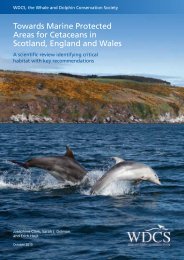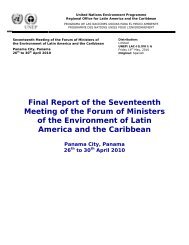Sea Turtle Recovery Action Plan for Barbados - WIDECAST
Sea Turtle Recovery Action Plan for Barbados - WIDECAST
Sea Turtle Recovery Action Plan for Barbados - WIDECAST
Create successful ePaper yourself
Turn your PDF publications into a flip-book with our unique Google optimized e-Paper software.
<strong>Barbados</strong> <strong>Sea</strong> <strong>Turtle</strong>s …<br />
to large amounts of herbicides. The relative bareness of the soil under vegetable cultivation<br />
compared to that under cane cultivation means that more soil is eroded by wind and rain. In<br />
addition, the soil is heavily fertilized (nitrates and phosphates) to allow several vegetable crops<br />
to be grown on each field per season. The increasingly heavy use of herbicides, pesticides, and<br />
fertilizers increases the pollutant composition of run-off. Changing agricultural practises may<br />
also cause an increase in the suspended particulate matter (SPM) load, as well as the amount of<br />
nitrates and phosphates in coastal marine waters.<br />
SPM stresses marine organisms in a number of ways, such as by decreasing light<br />
penetration and reducing the growth rate of corals, by physically smothering corals, and by<br />
impairing fish respiration. Sediment-covered surfaces restrict larval settlement, and large<br />
quantities of SPM settling and decomposing on a reef cause an increase in bacterial activity. In<br />
small quantities, nitrates and phosphates are important nutrients needed <strong>for</strong> the metabolic<br />
processes of living organisms. In excessive quantities, however, they cause phytoplankton<br />
blooms blocking light and decreasing the rate of coral growth. Sewage is another source of<br />
SPM, and of inorganic nutrients as well. With the exception of one major sewage treatment<br />
system in Bridgetown, sewage is disposed into septic tanks or pits. These are either<br />
'soak-aways', or the contents are piped a short distance offshore and released. A sewage<br />
treatment system will be constructed to serve the needs of the south coast in the near future, and<br />
one is also planned <strong>for</strong> the west coast. One option is that lightly treated sewage will be deposited<br />
offshore beyond the bank reef and in-to currents which will carry the sewage away from the<br />
island. Such a system is preferable to heavy chemical treatment and deposition closer to shore.<br />
Some of the chemicals used in sewage treatment (e.g., chlorine) may be more lethal to corals<br />
than the sewage itself, and treatment to remove nitrates and phosphates is too costly.<br />
The effects of pesticides and herbicides on nearshore marine communities in <strong>Barbados</strong><br />
are unknown, but east coast fishermen partially attribute the decline in sea eggs (Tripnuestes<br />
ventricosus) to the effects of pesticides on nearshore sea grass communities. Attempts to<br />
investigate this problem quantitatively are currently underway. Since a variety of nearshore<br />
marine communities, most notably sea grass beds and coral reefs, are essential <strong>for</strong> the survival of<br />
depleted sea turtle stocks in <strong>Barbados</strong>, this in<strong>for</strong>mation will also be useful in implementing a<br />
national recovery strategy <strong>for</strong> sea turtles.<br />
4.147 Others<br />
Careless anchoring of boats on coral reefs and the dragging of anchors and anchor chains<br />
causes an unquantified amount of damage, particularly to coral reefs situated off the west coast.<br />
Mooring facilities are greatly needed, particularly on the west coast, to accommodate visitation<br />
to coral reef areas. The <strong>Barbados</strong> Marine Reserve is protected by legislation (section 4.21) that<br />
prohibits damaging anchoring and fishing practices within a small designated area of the west<br />
coast nearshore waters. Elsewhere, inexpensive and effective mooring technologies, such as<br />
those designed by Halas (1985), should be installed in <strong>Barbados</strong> as soon as possible. Land has<br />
recently been reclaimed and the sea floor dredged <strong>for</strong> the construction of fish markets at Oistins<br />
and in Bridgetown. The effects of these constructions on current movements are unknown, but a<br />
short-term effect has been a substantial lowering of the clarity of water in the area. Hotels and<br />
houses on the west and south coasts often dispose of kitchen waste water through short drainage<br />
Page 21

















